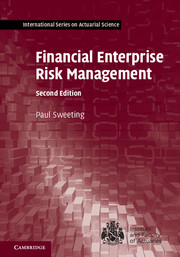Book contents
- Frontmatter
- Contents
- Preface
- 1 An Introduction to Enterprise Risk Management
- 2 Types of Financial Institution
- 3 Stakeholders
- 4 The Internal Environment
- 5 The External Environment
- 6 Process Overview
- 7 Definitions of Risk
- 8 Risk Identification
- 9 Some Useful Statistics
- 10 Statistical Distributions
- 11 Modelling Techniques
- 12 Extreme Value Theory
- 13 Modelling Time Series
- 14 Quantifying Particular Risks
- 15 Risk Assessment
- 16 Responses to Risk
- 17 Continuous Considerations
- 18 Economic Capital
- 19 Risk Frameworks
- 20 Case Studies
- 21 Solutions to Questions
- References
- Index
4 - The Internal Environment
Published online by Cambridge University Press: 12 August 2017
- Frontmatter
- Contents
- Preface
- 1 An Introduction to Enterprise Risk Management
- 2 Types of Financial Institution
- 3 Stakeholders
- 4 The Internal Environment
- 5 The External Environment
- 6 Process Overview
- 7 Definitions of Risk
- 8 Risk Identification
- 9 Some Useful Statistics
- 10 Statistical Distributions
- 11 Modelling Techniques
- 12 Extreme Value Theory
- 13 Modelling Time Series
- 14 Quantifying Particular Risks
- 15 Risk Assessment
- 16 Responses to Risk
- 17 Continuous Considerations
- 18 Economic Capital
- 19 Risk Frameworks
- 20 Case Studies
- 21 Solutions to Questions
- References
- Index
Summary
Introduction
The nature of an organisation is important to the risk management context. However, none is a simple, featureless institution; nor does any operate in a vacuum. The nature of each organisation and what surrounds it influences its operation fundamentally.
Understanding the internal environment is crucial for understanding the way in which risk management should be approached. An analysis of the various aspects of an organisation's internal risk environment helps risk managers within an organisation to appreciate what they need to do to carry out their roles effectively. It also helps external analysts to determine the risks that an organisation is taking – even if the organisation itself does not appreciate these risks
Internal Stakeholders
The only internal stakeholders that have a principal relationship with an organisation are owner-managers – all other internal stakeholders are agents, acting on behalf of an organisation's shareholders, customers, clients and so on. Their views of risk form an important aspect of the risk management environment, and they are discussed together with external stakeholders in Chapter 5. However, as well as their individual views of risk, the ways in which they interact are an important determinant of the way in which organisations behave. At the head of a firm, this means the board of directors. This group includes executive directors who have a day-to-day role in managing the firm and who are led by the chief executive, and non-executives who are responsible for representing the interests of shareholders. The board of directors is led by the chairman.
The executive directors delegate much of the running of the firm to managers, and ultimately to employees. Depending on the industry, the employees may be represented to a greater or lesser extent by trade unions. This, too, will affect the internal environment of the firm.
There are also issues for pension schemes through the structure of trustee bodies. The inclusion of member-nominated trustees can lead to a better reflection of the interests of members, whilst trustee boards dominated by employer-nominated trustees can at times give too great an emphasis to the interests of the sponsor. Using independent trustees can add valuable expertise to the trustee group. The trustees of endowments and foundations are similarly affected.
- Type
- Chapter
- Information
- Financial Enterprise Risk Management , pp. 54 - 61Publisher: Cambridge University PressPrint publication year: 2017



